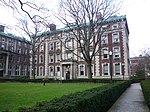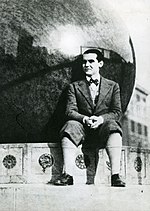The Great God Pan (sculpture)
1899 sculptures1907 establishments in New York CityAncient Greece in art and cultureBronze sculptures in ManhattanColumbia University campus ... and 7 more
Musical instruments in artNude sculptures in New York (state)Outdoor sculptures in ManhattanRelocated buildings and structures in New York CitySculptures by George Grey BarnardSculptures of Pan (god)Statues in New York City

The Great God Pan (cast 1898–1899) is a bronze sculpture by American sculptor George Grey Barnard. Since 1907, it has been a fixture of the Columbia University campus in Manhattan, New York City.
Excerpt from the Wikipedia article The Great God Pan (sculpture) (License: CC BY-SA 3.0, Authors, Images).The Great God Pan (sculpture)
Low Library Steps, New York Manhattan
Geographical coordinates (GPS) Address Website Nearby Places Show on map
Geographical coordinates (GPS)
| Latitude | Longitude |
|---|---|
| N 40.808222222222 ° | E -73.962555555556 ° |
Address
Columbia University (Columbia University in the City of New York)
Low Library Steps
10027 New York, Manhattan
New York, United States
Open on Google Maps






